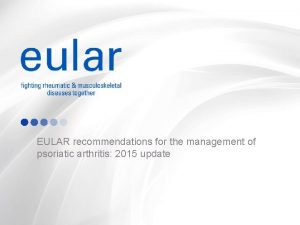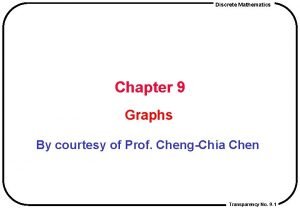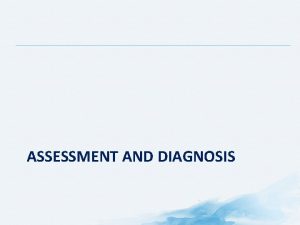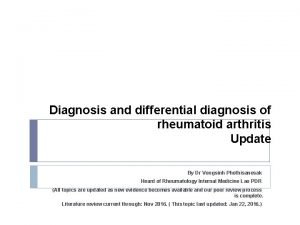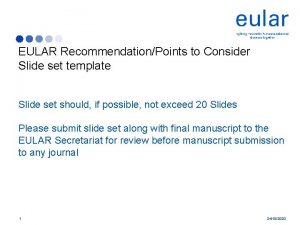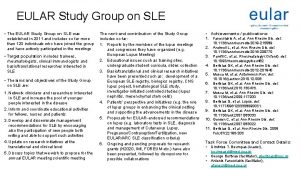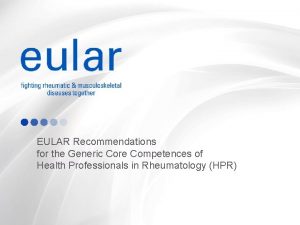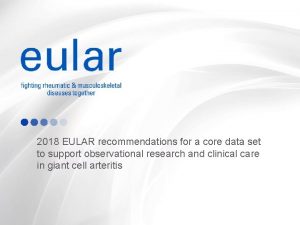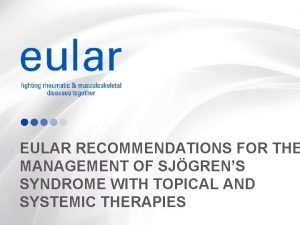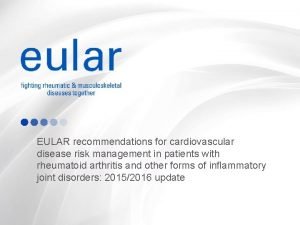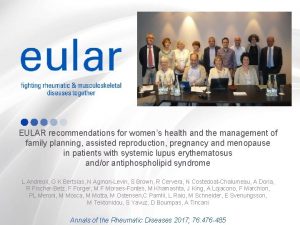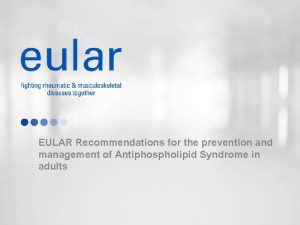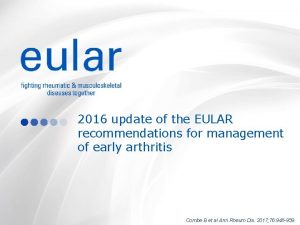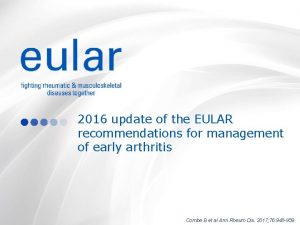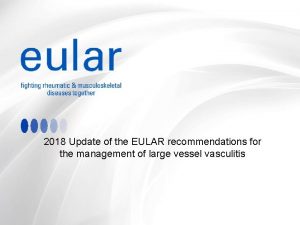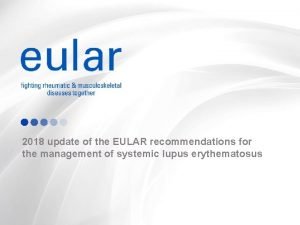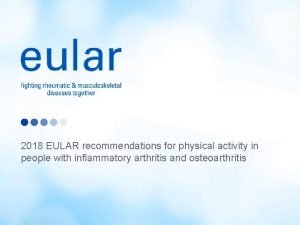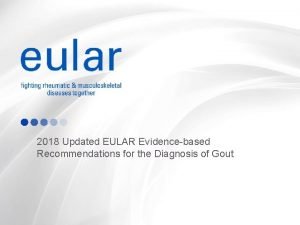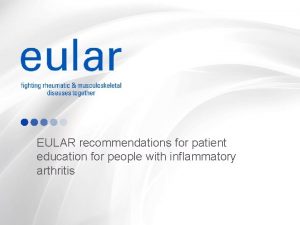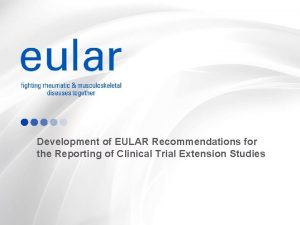EULAR recommendations for the nonpharmacological core management of



















- Slides: 19

EULAR recommendations for the non-pharmacological core management of hip and knee osteoarthritis

Target population/question • Aim: to develop evidence -based recommendations and a research and educational agenda for the nonpharmacological management of hip and knee osteoarthritis (OA). • Target population: all healthcare providers involved in the delivery of non-pharmacological interventions, people with hip or knee OA, researchers in the field of OA, officials in healthcare governance, reimbursement agencies and policy makers. 2 04/03/2021

Methods/methodical approach • Methods: According to the EULAR Standardized Operating Procedures* Consensual approach Systematic literature research Consensual approach FINAL Recommendations * van der Heijde et al Ann Rheum Dis 2016, 75: 3 -15 3 04/03/2021

Recommendation 1 In people with hip or knee OA, initial assessments should use a biopsychosocial approach including: a. Physical status (including pain; fatigue; sleep quality; lower limb joint status (foot, knee, hip); mobility; strength; joint alignment; proprioception and posture; comorbidities; weight) b. Activities of daily living c. Participation (work, education, leisure, social work) d. Mood e. Health education needs, health beliefs and motivation to selfmanage 4 04/03/2021

Recommendation 2 Treatment of hip and/or knee OA should be individualised according to the wishes and expectations of the individual, localisation of OA, risk factors (such as age, sex, comorbidity, obesity and adverse mechanical factors), presence of inflammation, severity of structural change, level of pain and restriction of daily activities, societal participation and quality of life 5 04/03/2021

Recommendation 3 All people with knee/hip OA should receive an individualised management plan (a package of care) that includes the core nonpharmacological approaches, specifically: a. information and education regarding OA b. addressing maintenance and pacing of activity c. addressing a regular individualised exercise regimen d. addressing weight loss if overweight or obese e. reduction of adverse mechanical factors (eg, appropriate footwear) f. consideration of walking aids and assistive technology 6 04/03/2021

Recommendation 4 When lifestyle changes are recommended, people with hip or knee OA should receive an individually tailored programme, including long-term and short-term goals, intervention or action plans, and regular evaluation and follow-up with possibilitiesfor adjustment of the programme 7 04/03/2021

Recommendation 5 To be effective, information and education for the person with hip or knee OA should: a. be individualised according to the person’s illness perceptions and educational capability b. be included in every aspect of management c. specifically address the nature of OA (a repair process triggered by a range of insults), its causes (especially those pertaining to the individual), its consequences and prognosis d. be reinforced and developed at subsequent clinical encounters; e. be supported by written and/or other types of information (eg, DVD, website, group meeting) selected by the individual f. include partners or carers of the individual, if appropriate 8 04/03/2021

Recommendation 6 The mode of delivery of exercise education (eg, individual 1 : 1 sessions, group classes, etc) and use of pools or other facilities should be selected according both to the preference of the person with hip or knee OA and local availability. Important principles of all exercise include: a. ‘small amounts often’ (pacing, as with other activities) b. linking exercise regimens to other daily activities (eg, just before morning shower or meals) so they become part of lifestyle rather than additional events c. starting with levels of exercise that are within the individual’s capability, but building up the ‘dose’ sensibly over several months 9 04/03/2021

Recommendation 7 People with hip and/or knee OA should be taught a regular individualised (daily) exercise regimen that includes: a. strengthening (sustained isometric) exercise for both legs, including the quadriceps and proximal hip girdle muscles (irrespective of site or number of large joints affected) b. aerobic activity and exercise c. adjunctive range of movement / stretching exercises * Although initial instruction is required, the aim is for people with hip or knee OA to learn to undertake these regularly on their own in their own environment 10 04/03/2021

Recommendation 8 Education on weight loss should incorporate individualised strategies that are recognised to effect successful weight loss and maintenance—for example: a. regular self-monitoring, recording monthly weight b. regular support meetings to review/discuss progress c. increase physical activity d. follow a structured meal plan that starts with breakfast e. reduce fat (especially saturated) intake; reduce sugar; limit salt; increase intake of fruit and vegetables (at least ‘ 5 portions’ a day) f. limit portion size; g. addressing eating behaviours and triggers to eating (eg, stress) h. nutrition education i. relapse prediction and management (eg, with alternative coping strategies) 11 04/03/2021

Recommendation 9 The use of appropriate and comfortable shoes is recommended. 12 04/03/2021

Recommendation 10 Walking aids, assistive technology and adaptations at home and/or at work should be considered, to reduce pain and increase participation—for example: a. a walking stick used on the contralateral side, walking frames and wheeled ‘walkers’ b. increasing the height of chairs, beds and toilet seats c. hand-rails for stairs d. replacement of a bath with a walk-in shower e. change to car with high seat level, easy access and automatic gear change 13 04/03/2021

Recommendation 11 People with hip or knee OA at risk of work disability or who want to start/return to work should have rapid access to vocational rehabilitation, including counselling about modifiable work-related factors such as altering work behaviour, changing work tasks or altering work hours, use of assistive technology, workplace modification, commuting to/from work and support from management, colleagues and family towards employment 14 04/03/2021

Summary Table Oxford Level of Evidence 1. Ib, mixed 2. Ib, mixed; Ib, knee 3. Ib, hip; Ib, knee 4. Ib, mixed; Ib, knee 5. Ia, mixed 6. Ia, knee, delivery mode; Ia, mixed, water-based exercise 7. Ia, hip, overall exercise; Ia, knee, strength; Ia, knee, aerobic; Ia, mixed programmes 8. III, hip; Ia, knee 9. Ib, knee. 10. III, hip; III, knee 11. III, hip; III, knee; Ib, mixed, sick leave 15 04/03/2021

Summary 1. Initial assessments should use a biopsychosocial approach 2. Treatment of hip and/or knee OA should be individualised 3. All people with knee/hip OA should receive an individualised management plan (a package of care) 4. For lifestyle changes people with hip or knee OA should receive an individually tailored programme 5. To be effective, information and education for the person with hip or knee OA should meet specific requirements 6. The mode of delivery of exercise should be selected according both personal preferences and local availability. 16 04/03/2021

Summary 6. Important principles of all exercise include: ‘small amounts often’, linking exercise regimens to other daily activities and building up the ‘dose’ over time. 7. A regular individualised (daily) exercise regimen should includes strengthening, aerobic activity and range of movement / stretching exercises 8. Education on weight loss should incorporate individualised strategies that are recognised to effect successful weight loss and maintenance 9. The use of appropriate and comfortable shoes is recommended 10. Walking aids, assistive technology and adaptations at home and/or at work should be considered, to reduce pain and increase participation 11. People with hip or knee OA at risk of work disability or who want to start/return to work should have rapid access to vocational rehabilitation 17 04/03/2021

Lay Summary Eleven evidence-based recommendations for the nonpharmacological core management of hip and knee OA were developed, concerning the following nine topics: • general approach, • assessment, • patient information and education, • lifestyle changes, • exercise, • weight loss, • assistive technology and adaptations, • footwear and work. 18 04/03/2021

Acknowledgements Fernandes L, Hagen KB, Bijlsma JW, Andreassen O, Christensen P, Conaghan PG, Doherty M, Geenen R, Hammond A, Kjeken I, Lohmander LS, Lund H, Mallen CD, Nava T, Oliver S, Pavelka K, Pitsillidou I, da Silva JA, de la Torre J, Zanoli G, European League Against Rheumatism (EULAR) 19 04/03/2021
 Gossec
Gossec Graph discrete mathematics
Graph discrete mathematics Oa grade 2
Oa grade 2 Eular
Eular Rheumatoid arthritis in hands
Rheumatoid arthritis in hands Eular criteria for ra
Eular criteria for ra Eular
Eular The brittle, rocky outer layer of earth
The brittle, rocky outer layer of earth Earth crust thickness
Earth crust thickness Basic layers of the earth
Basic layers of the earth Core capabilities and core rigidities
Core capabilities and core rigidities Iso 22301 utbildning
Iso 22301 utbildning Typiska drag för en novell
Typiska drag för en novell Tack för att ni lyssnade bild
Tack för att ni lyssnade bild Ekologiskt fotavtryck
Ekologiskt fotavtryck Varför kallas perioden 1918-1939 för mellankrigstiden
Varför kallas perioden 1918-1939 för mellankrigstiden En lathund för arbete med kontinuitetshantering
En lathund för arbete med kontinuitetshantering Särskild löneskatt för pensionskostnader
Särskild löneskatt för pensionskostnader Personlig tidbok fylla i
Personlig tidbok fylla i Anatomi organ reproduksi
Anatomi organ reproduksi
